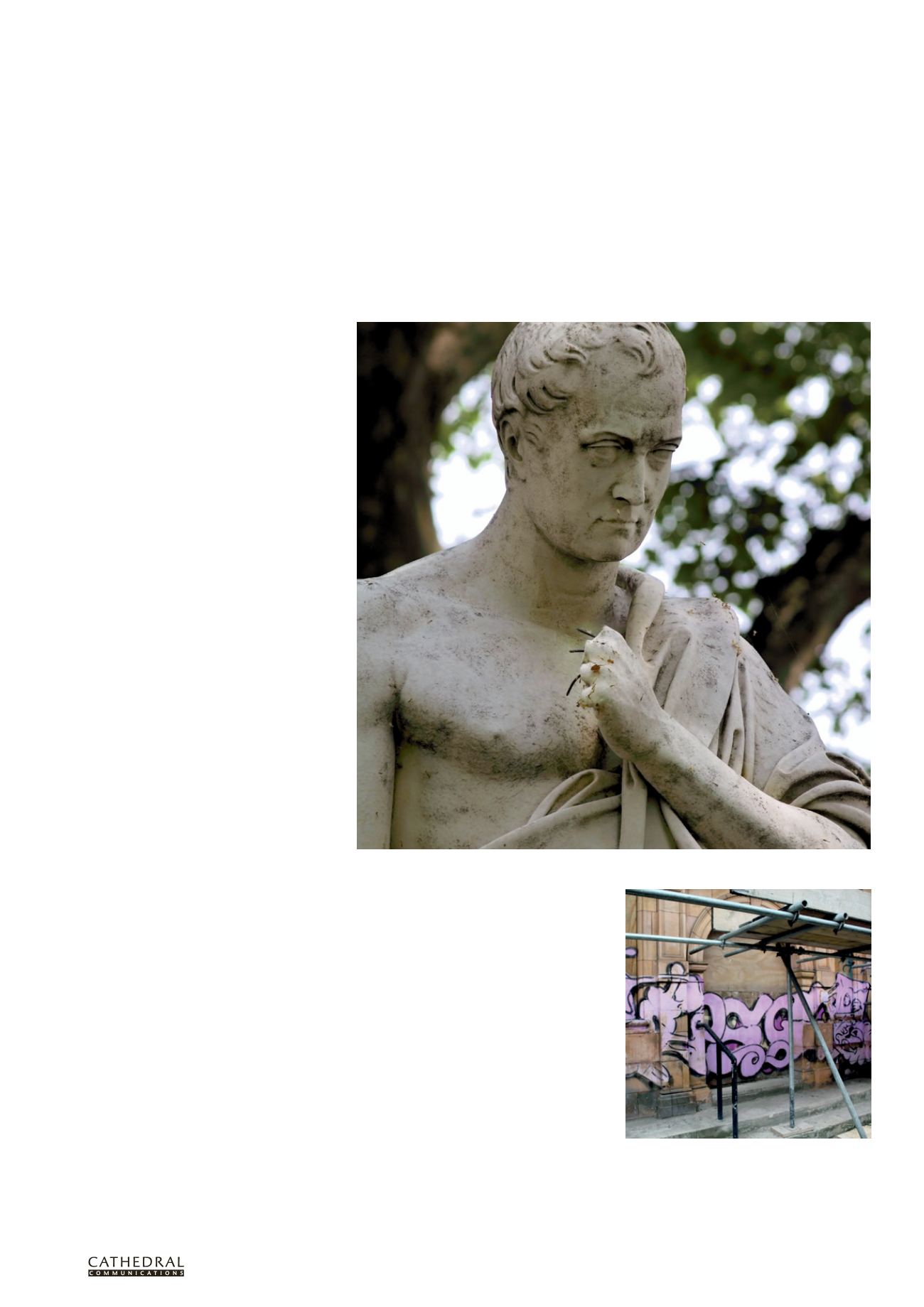
T W E N T Y F I R S T E D I T I O N
T H E B U I L D I N G C O N S E R VAT I O N D I R E C T O R Y 2 0 1 4
9 3
3.2
STRUCTURE & FABRIC :
MASONRY
‘I WOZ ERE’
REPAIRING PUBLIC MONUMENTS AND SCULPTURE
LUCY BRANCH
T
HE VANDALISM
and theft of monuments
has never been more topical. In July
this year the BBC reported nine news
stories on the vandalism of heritage compared
to none in the whole of 2008. The launch of
initiatives such as the Alliance to Reduce
Crime Against Heritage, the Heritage Crime
Programme and the Association of Chief
Police Officers’ Metal Theft Working Group,
suggests that the conservation community
is concerned that the stories that hit the
headlines are just the tip of the iceberg. There
is a strong sense that this is a critical time
and that steps must be taken to prevent the
problem escalating further.
Because so few acts of vandalism or theft
result in prosecution, few firm statistics exist
and it is hard to track annual changes in the
nature and frequency of this type of crime.
However, press coverage over the last decade
indicates that the most high profile statues
have regularly attracted abuse while theft
within this group has also risen.
According to the Public Monuments and
Sculpture Association (PMSA), although the
theft of public sculpture has certainly become
more appealing to criminals since the price of
copper alloys increased, it is by no means clear
that scrap value is the only reason for this
worrying trend.
There is a common assumption that the
motivation for all the theft and vandalism
associated with our heritage can be summed
up in two words: money and ignorance.
Taking the trouble to consider carefully why
an object has been vandalised makes for
better conservation decisions, and sometimes
reveals a slightly less bleak picture of the
human race, which must be good for any
conservator’s soul.
Iconoclasm
The destruction of cultural
property for political or religious ideals. This
type of vandalism is probably as old as art
itself. A current exhibition at Tate Britain, ‘Art
under Attack: Histories of British Iconoclasm’,
explores such attacks on art in Britain since
the 16th century. The objects on display
demonstrate that this type of vandalism is not
a modern phenomenon.
In March 2011, anti-cuts protests took
place following a TUC rally which left
Trafalgar Square and other parts of central
London in a mess. The damage cost tens of
thousands of pounds to repair according
to a council official. Protesters daubed red
and black paint on monuments and on the
Olympic countdown clock in Trafalgar Square.
Celebration
Sometimes out of sheer
exuberance, people feel the need to ‘decorate’
a sculpture or climb to its highest point. This
may take the form of applying lipstick or
placing a jaunty traffic cone on a monument’s
head. Particularly during sporting events and
even elections, the desire to climb sculptures
seems to be overwhelming for some.
Riots may be hard to predict but we can
anticipate many of the sporting events that
will excite the nation and often have advance
warning about demonstrations and protests.
Temporary hoarding of monuments that
have a history of being targeted can help to
prevent further serious abuse. Although not
particularly aesthetically pleasing, there are
examples of innovation in this area such as
protecting London’s Shaftesbury Memorial
from New Year’s Eve revellers by enclosing it
in a protective plastic dome which was styled
to imitate a snow globe.
Statue of William Huskisson in Pimlico Gardens, London, which was repeatedly targeted by vandals
The swift removal of graffiti tags undermines the
tagger’s objective of self-advertisement while also
reducing the likelihood of damage being caused by
the paint remaining in contact with the surface over
a period of time. (Photo: Restorative Techniques)


